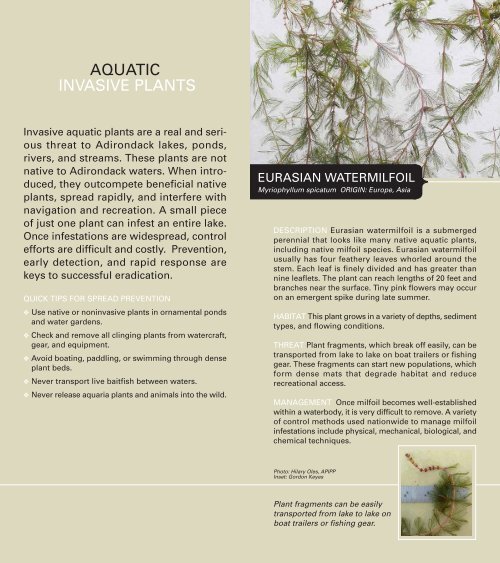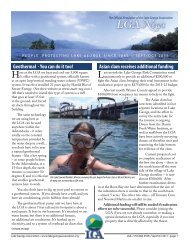Invasive Plants of the Adirondacks - Adirondack Park Invasive Plant ...
Invasive Plants of the Adirondacks - Adirondack Park Invasive Plant ...
Invasive Plants of the Adirondacks - Adirondack Park Invasive Plant ...
You also want an ePaper? Increase the reach of your titles
YUMPU automatically turns print PDFs into web optimized ePapers that Google loves.
AQUATIC<br />
INVASIVE PLANTS<br />
<strong>Invasive</strong> aquatic plants are a real and serious<br />
threat to <strong>Adirondack</strong> lakes, ponds,<br />
rivers, and streams. These plants are not<br />
native to <strong>Adirondack</strong> waters. When introduced,<br />
<strong>the</strong>y outcompete beneficial native<br />
plants, spread rapidly, and interfere with<br />
navigation and recreation. A small piece<br />
<strong>of</strong> just one plant can infest an entire lake.<br />
Once infestations are widespread, control<br />
efforts are difficult and costly. Prevention,<br />
early detection, and rapid response are<br />
keys to successful eradication.<br />
QUICK TIPS FOR SPREAD PREVENTION<br />
v Use native or noninvasive plants in ornamental ponds<br />
and water gardens.<br />
v Check and remove all clinging plants from watercraft,<br />
gear, and equipment.<br />
v Avoid boating, paddling, or swimming through dense<br />
plant beds.<br />
v Never transport live baitfish between waters.<br />
v Never release aquaria plants and animals into <strong>the</strong> wild.<br />
EURASIAN WATERMILFOIL<br />
Myriophyllum spicatum ORIGIN: Europe, Asia<br />
DESCRIPTION Eurasian watermilfoil is a submerged<br />
perennial that looks like many native aquatic plants,<br />
including native milfoil species. Eurasian watermilfoil<br />
usually has four fea<strong>the</strong>ry leaves whorled around <strong>the</strong><br />
stem. Each leaf is finely divided and has greater than<br />
nine leaflets. The plant can reach lengths <strong>of</strong> 20 feet and<br />
branches near <strong>the</strong> surface. Tiny pink flowers may occur<br />
on an emergent spike during late summer.<br />
HABITAT This plant grows in a variety <strong>of</strong> depths, sediment<br />
types, and flowing conditions.<br />
THREAT <strong>Plant</strong> fragments, which break <strong>of</strong>f easily, can be<br />
transported from lake to lake on boat trailers or fishing<br />
gear. These fragments can start new populations, which<br />
form dense mats that degrade habitat and reduce<br />
recreational access.<br />
MANAGEMENT Once milfoil becomes well-established<br />
within a waterbody, it is very difficult to remove. A variety<br />
<strong>of</strong> control methods used nationwide to manage milfoil<br />
infestations include physical, mechanical, biological, and<br />
chemical techniques.<br />
Photo: Hilary Oles, APIPP<br />
Inset: Gordon Keyes<br />
<strong>Plant</strong> fragments can be easily<br />
transported from lake to lake on<br />
boat trailers or fishing gear.
















